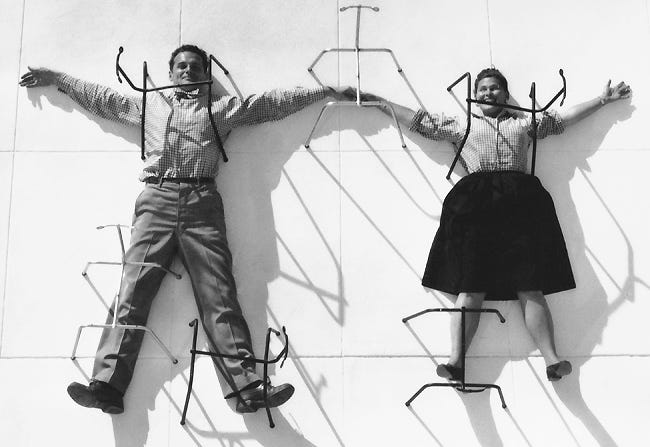February 11, 2019 - Comments Off on A Tryst with Charles and Ray Eames
A Tryst with Charles and Ray Eames
At the recent Kochi Biennale*, I was pleasantly surprised to see an Eames exhibit — Powers of Ten— playing on loop on a large screen in a dark room.
Made in 1977, this simple film is still captivating because it’s relatable and seems to be designed for the viewer to just…get it. Although everything from geography to astronomy, biology and mathematics is traversed in under nine minutes, the big picture still shines through in one cohesive story.
*The Kochi-Muziris Biennale is an international exhibition of contemporary art held in Kochi. Like the SXSW at Austin, it’s an event that promotes the discovery of creativity.
Discovering the Eameses
I first came across the India Report when I was a student at the National Institute of Design, Bangalore. (If you go through the wiki entry, you’ll notice that NID itself was started as a result of said report.)
I’d already heard of the Eameses, but my knowledge of them was vague. As I read through the clear, well thought-out sentences, it appeared to me that Charles and Ray Eames were not just thinkers and doers — they lived a life of authenticity and discovery, and had a focussed devotion to making with intention.
I was itching to put them in some kind of a box. But the more I saw and read, the harder it was to find a box that fit.
I heard the gentle voice of Charles Eames defining design in ‘Design Q & A’. I saw their ideas become exhibitions like Mathematica. I saw their eye for detail in the Eames Lounge Chair.

Who were these people? How do you categorize a team that’s introduced over 900 designs for furniture, toys, exhibitions, film, graphics and architecture?
My interest in the Eameses led me to discover a few traits that formed the foundation of their work and life.
Perspectivity
Always striving for a new perspective, the Charles and Ray Eames catalogued a collection of 350,000 slides of photographs — their own ‘cabinet of curiosity’. They used film and photography extensively to step back and look at the world around them in new ways.
Before building the Eames House, Charles Eames wrote on a piece of paper — “What is a house?”
Taking pleasure seriously

Charles Eames famously said “It makes me feel guilty that anybody should have such a good time doing what they are supposed to do.”
Much of the Eameses’ work was a result of enjoying and celebrating life through design. The Solar-Do-Nothing machine, gifts for their grandchildren and even letters written by Charles Eames to his daughter, all stand testimony to this playful approach.
Exceptional empathy
Charles and Ray Eames understood that empathy is paramount in crafting a design solution.
“One of the things we hit upon was the quality of a host. That is, the role of the architect, or the designer, is that of a very good, thoughtful host, all of whose energy goes into trying to anticipate the needs of his guests — those who enter the building and use the objects in it. We decided that this was an essential ingredient in the design of a building or a useful object.”
Thus, any solution was a result of caring deeply for the user and getting truly involved with the problem.
Endless iteration
Work at the Eames office mostly dealt with continuous refinement of solutions, as their deep engagement with a project allowed for new connections to emerge. The Eames chairs were known to be reworked on over years, as newer, more apt materials became available.
Charles was once asked, “Did you think of the Eames chair in a flash?”
He replied, “Yes, sort of a 30-year flash.”
There is a lot to be absorbed from the two iconic makers, and I’m certainly inspired to use what I’ve learned from them in my own way.
Published by: angelinein in Uncategorized
Comments are closed.